ANTONIS ANTONIOU
Antonis Antoniou is a visual artist and performer. He graduated from the Fine Arts School of Athens in 2014, under professor Marios Spiliopoulos. In 2012 he attended drawing, painting, sculpture and photography at Barcelona University (UDB), funded by an Erasmus scholarship. Expressed through various media (performances, video, video installations etc.), his work explores the relationship between body, space, and/or sociopolitical context. Antonis has shown his work in festivals, exhibitions and artistic residencies in Greece and abroad. Recent participations: Art Athina, Petit Paris d’ Athènes, Art and Madness (Insitution Melina Mercouri), Cipaf festival Cyprus, electric Night Vol.3, in collaboration with Palais de paris / BETON7 / Contemporary Art Showcase (Athens-Tokyo), Transmission Arts Festival, Athens Biennale
https://antoniou2.wixsite.com/antonis
Ακάλυπτος/ Exposed
What is promised from a surface and how is it proclaimed? What is it that a surface and it’s projection on furniture, walls, the empty lot outside one’s window make us feel? Scars and markings of a transient body are projected on a larger scale in and outside the room. What is very private enters the public space and becomes a spectacle. The action aims at making an improvised dance score, with a duration of two hours. He will be working on the notions of within and without, trying to create, through the projection of magnified details of his body, liaisons between the two. For the documentation of the body he will use a microscope, linked to a projector.
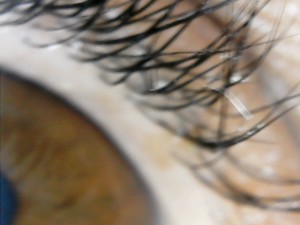
Link to the video: https://vimeo.com/455896674
(the video does not show the action broadcast in live streaming during the GOLEM – event but a “sister” performance that took place at the IFPA – International Forum of Performance Art)
::
YANNIS ADONIOU & ANDRIUS MULOKAS | KUNST-STOFF PRODUCTIONS
Yannis Adoniou
Yannis Adoniou’s work challenges and reconsiders the established knowledge and social behavior that we have been taught and speaks about finding one’s personal truth. Born in Athens, Greece he received his formal dance education at the Greek National Dance School (KSOT) and Hamburg Ballet School in Germany. Since 1998 he has been leading the critically acclaimed arts organization, KUNST-STOFF productions. Adoniou’s latest work was commissioned and presented by Marina Abramovic Institute and NEON foundation. Adoniou was a principal dancer with Alonzo King’s LINES Ballet, the San Fransisco Opera and a regular guest artist across the USA and Europe.
Andrius Mulokas
After studying Visual Arts (Kaunas College) and Architecture (Vilnius Art Academy), Andrius Mulokas’s artistic interest shifted to how a moving body can inform the space. He studied dance in Finland (North Karelia College) and later moved to Amsterdam where he was invited to the BA in Choreography program SNDO (AHK).Born in 1983 in Kaunas, Lithuania, he is currently based in Athens, Greece. He has collaborated and participated in the works by Tino Sehgal, Deborah Hay, Doris Uhlich ,Marina Abramovic ,Florentina Holzinger, Benoit Lachambre, Ann Liv Young ,Lea Moro and others.
Andrius’ work is about the state of possession by movement, about relationships with objects, materials that become performers, about the labour of performance art and the expressive forms it takes. Being in a position of an artist requires a certain attitude towards playing. Inside culture this attitude persist. –
Yannis Adoniou and Andrius Mulokas are presenting a common piece, created on the basis of their common referents: their interest in dance in relevance to the surrounding environment as well as movement in a social context.
For the very 1st time
transmission – space – body – time – daydreaming – free and abandon creation <tune in the moment> as of “for the very 1st time”. Immersing oneself in the process of practice. Sky is the limit, but nevertheless is out of reach. Join us in attempt.
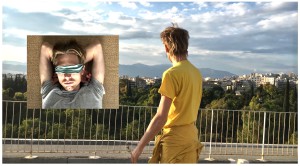
::
LUCIA BRICCO
Title: Dissertazione (Dissertation), Duration: 25’, Materials: sea, clothes, sticks, string, wind
Dissertazione (Dissertation) is a speech in which the words used between the interlocutors, and so their movements and their demonstrations, coincide with the argument of the discussion: the deformity of words.
Statement
Central in Lucia Bricco’s work is space and the dynamics capable to create more space in it. Rather than aiming for synthesis, it consists of multitude, multiplication, complexity, and opposition, therefore it remains difficult to establish a single center within it.
Bio
Lucia Bricco (Turin, 1988) is an Italian artist based in Athens (GR) since 2018. She studied at the Academy of Fine Arts in Turin, Madrid, and Rome. She got her master’s degree in 2015 with the thesis “In Between, investigation on the vision. Study of the possibilities of living an exchange”. Her work focuses on space, approached in both a private and a collective way. She’s interested in the coexistence, complexity, and changeability of elements.
Since 2015 she has taken part in several residencies, exhibitions and performance festivals in Italy, Spain, Poland, Ukraine, Germany, Greece, France, Czech Republic, Belarus, such us: 2019 ZABIH Performance Festival, Lviv (UA), Performensk, Minsk (BY), This is the girl, A.T.E.N.A., Sète (FR), Platform Project ‘19 as a representative of Sub Rosa Space in Athens (GR). 2018 she organizes the events Turin Table – Performance Art Week with the support of the city of Turin, and The Exhibition in a little Swimming Pool in Athens; 2017 Extrem moment as lasting value, performance workshop led by Helge Meyer in Köln (DE); Forming inattention: becoming lost, workshop by Sandra Johnston in Museumsbahnsteig, Oberhausen (DE); Performance Platform Lublin ad workshop Performance as experiment, led by Marylin Arsem, Galeria Labirynt, Lublin (PL);2016 Rome meet Glasgow, Museo MACRO Testaccio, Rome (IT); Fuori uso, Pescara(IT) 2015/16 Citè internationale des Arts, residency in Paris (FR). 2015, Uscita d’emergenza, MACRO Testaccio Museum in Rome (IT); Siderare ’15, Fondazione VOLUME!, Rome (IT); The Others, Premio Rock The Academy, Ex Carcere Le Nuove, Torino (IT); Premio Abbado, first prize video-installation.
Website: www.luciabricco.com
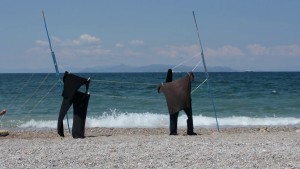
https://www.luciabricco.com/dissertazione
::
NICOLA FORNONI
Performance art is like life and dream. it’s a magic and beneficial weapon to fight inequities and, moreover, to use action like universal language. I use my body through video and actions talking about mental and body instinct to go over limits. I believe in the sound and image power to get out energies and feelings. i use to connect some ideas with anthropological elements and i think that body is an experience to go into and out abstract and real projections and memories.
I usually create long durational and lately I began to think about video on desire, time, eternity like an interior journey. Actions take time and they are focused on wishes, positive growth of spirit and wellness of thoughts and feelings. I try to abandon every pain to overwhelmed negativity, searching for the truth.
DRAGONFLY
Dragonfly is an unpublished video talking about transformation in a gold and light being of freedom and eternal shine, like an ancient greek funeral mask, or an insect armor. The movement is marked in stop emotion and my research is focused on a large view of life through outside and inside. A long discovery of oneself, a study of own movements and aesthetic images of own body that time could be changing so fast and so slowly.
https://www.nicolafornoni.com/
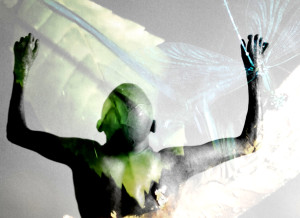
https://www.nicolafornoni.com/dragonfly-2020
::
ATHINA KANELLOPOULOU
My art practice consists of performance acts focusing on the human factor as a small part of the world. Conceptual questions are derived to create a space, in which they take different forms on altered occasions. Thus, my artwork deals in subjects, ranging from ecology and urban-scape skepticism, to human beings as a social part, their specific elements of identities, rights, fears, thoughts and interactions, with concepts such as feminism, human right equality and horizontal democracy being present as well. Engaging social art practice, audience participation is usually a main component in my structured environments, with influences from topoanalysis and Foucault’s theoretical basis about social spaces. For me the spatial and social elements play a key role in the way of perceiving the world; thus, I call space every real, digital, virtual, invented or imaginary place. I seek all things that are creating a transitory total, sometimes distancing myself to a mere observer, while other times being the leader, the guide to a journey within the person engaging in activities such as answering intimate questions, discussing with other individuals, co-creating an environment, participating in a feast, engaging interventional actions, etc. My specific practice focuses on creating big archives from the participatory questions or process, based on the beauty and plurality of this total, constructed by different identities. My artworks include a variety of mixed media: videos, installations, embroidery, voiced recordings etc.
Creating a floating island
The human entity constantly creates new objects and structures for use, dedicated to replacing the older things, set obsolete. Earth functions as a huge landfill, based on capitalism and modern consumerism. Could the already existing structures and objects be occupied through a function or series of poetic acts, aiming to reclaim a new aesthetic? In the project Creating a floating island, Kanellopoulou is performing a utopian intervention to a boat-wreck, left on the coast of Athenian Riviera; Βy importing soil and seeds to the deck and creating planting areas, Kanellopoulou creates a utopian coastal microclimate, seeking to reuse the floating wreck and relocate it from its primary and temporary situation; the artificial nature of such a boat is being changed and regenerated, turned into a vivid environmental floating structure, which will host entities of Plantae and Animalia. The new hosted species are going to be added over-water, in the body of the wreck, to its already existing ecosystem, that was created underwater during the period of its abandonment. Nature rules over the human creations, reclaiming an earthly reality for the specific space, after this poetic generative process.
https://www.athinakanellopoulou.com/
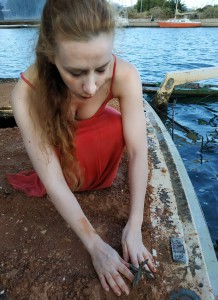
Link tothe video: https://www.youtube.com/playlist?list=PLzcV8V-EaV0xZZ21jPdr8R9738MN0WAa0
::
KANGELA TROMOKRATISCH
Kangela is a psychedelic housewife from Athens, the child of Angel Torticollis’ twisted mind.
Tile: Kangela’s quarantine
Kangela is all alone in her living room playing with her dolls.
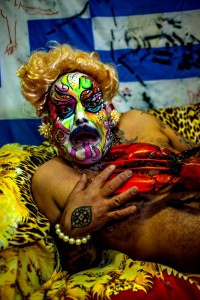
Link to the video: https://www.youtube.com/watch?v=Q5BcYPDLbFY&t=931s
::
MARTA LODOLA/ VALERIO AMBIVERI
Title: Non-human distance
The intermediate point between Berlin and Bergamo is Berching, the place set for the meeting between Marta Lodola and Valerio Ambiveri, on June 6, 2020, at 18.00.
In addition to being the third city starting with the letter ‘B’, Berching is the birthplace of Christoph Willibald Gluck, a coincidence feeling like predestination: the meeting between the two artists took place in Gluck’s place and the setting to the music of the meeting between Orpheus and Eurydice of 1762.
The 6th of June 2020 is the culmination of the ‘lockdown’ period imposed by the pandemic emergency of covid-19, in which social distancing begins to be perceived as a necessary inhumanity.
“Non-human distance” is the performance of the non-human encounter between the two artists, broadcasted on the net right before the reopening of the borders, when the possibility of bridging the distance with new human encounters is re-established, to sanction that only bodies have this power.
Marta Lodola I am a visual artist specialized in performance art. My artistic research point to study the relationships created amongst the body and Its surrounding context. I’m interested in the female body and its relationships within contemporary society. In reference, my work is based on discrimination, gender violence, social relationships and any kind of problems undermining the freedom of the individual. I consider art as a tool of opposition generating a counter-stream to homogenization of culture. For me art is a tool of resistance.
For me the female body is dual, is feminine, masculine and powerful beyond any simple representation. I get inspired by my daily life in order to create my actions, in fact I believe performance and life are tied up together. My path is a realization of my place in the world, I question myself about the truthfulness of my role within our society.
I work with performance site-specific, long durational, photographic self-timer, video and illustration. My actions are part of meditative states, catharsis, improvisation, body as a sculpture, installations.
https://martalodola.wordpress.com/
Valerio Ambiveri (Bergamo, 1962) is an Italian artist and professor of Digital Video and Performing Art at the Academy of Fine Arts of Brera in Milan.
The latest exhibitions are at the Nicola Trussardi Foundation, Phroom, Golem Athens and the opening of the virtual AMBImuseoVERI. http://www.valerioambiveri.org/
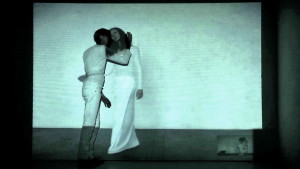
Link to the video: https://vimeo.com/430368148
::
ANDREAS PAPAMICHAEL
My primary concerns, from which I explore and create, are based on the observation of the cycle of life and the diptych nature–life, more specifically on human and non-human environmental impact perspectives. More concretely, I focus on the study of natural phenomena through erosion, recreation and how humans are impacting these, often underestimating the ultimate fundamental issue: the meaning of existence and questioning the meaning of life itself. Through these concepts, therefore, my artwork has been aimed at raising awareness of related environmental issues.
My creative method arises as a result of the systematic, almost obsessive exploration of nature and its phenomena, expressed in a variety of ways through art applications/ outputs of mixed media and installations involving a diversity of concepts. Most centrally, mythology informs my work as a mechanism from the past to engage fundamental aspects of contemporary environmental circumstances. For instance, the questions are raised by the use of past mythology and the creation of a contemporary mythology statement; the work focuses on a variety of aspects of mythology which are reinstated, giving a new contemporary form to my artistic inquiry. Thus, this employs aspects of mythology questioning human relations with the environment, as a continuum of looking back to address the present or the future to reinvent mythology and reinvigorate it into contemporary circumstances. In the last year, fire is the target tool/ medium with which I explore and create my work. My work with fire involves ceramics and sculptures out of burnt plastic waste or setting fire as part of artwork performances. For instance, the element of fire plays a central role in the background when firing the kiln to create ceramics. Moreover, when setting fire directly to the material, which in this case is plastic, the outcome is the creation of sculptures and installations out of burned structures of plastic waste. Fire is one of the main natural elements in Nature which is taking a key role in our human and non-human existence on the earth and the universe. Fire is essential not only for human use as a source of energy, but as a core element of the Earth’s natural and dynamically stable. From the core of the Earth to its surface and its climatic streams, fire stabilizes the fundamental temperatures that are vital for life on this planet. Using fire as a primordial element to my work, I am aiming to raise questions mostly about Cosmoecology and the cycle of life itself. Moreover, as part of MFA, Art Space & Nature, my artwork aims to make an impact in public spaces as thought provoking works, either with the immediate interaction and involvement of onlookers, or with the activation of spaces or points of the urban or natural environment. What is more, as an active member of environmental activism groups, my artwork practice is both influenced by and aims to integrate concrete environmental claims.
Eastern Mediterranean Straw Bale
A video showing a straw bale in an agricultural field context in Cyprus. The action’s final shape of the artwork is materialized in a video playing in a loop, showing a straw bale already set on fire, at the stage of full flame -a stable flame state throughout the video. This action is examining two separate but connected issues. Firstly, the burning bale geologically and ecologically depicts the portrait of the human epoch. Geologists have called our era the Anthropocene, the time when human aggression on the planet has outranked geological forces. More developed civilizations appeared at this point, but Anthropocene’s point in the history timeline is seen here not as the beginning of our species but rather, with the advent of modern capitalism. Humans seem to have been obliterating our planet -a planet on fire- mistreating nature as a raw material.
Following this, Promitheus’ gift is used as the element of fire, not curative but damaging. In this sense, it is referring to the myth of Titan Promitheus when he presented both fire and general knowledge for the good of humankind saving them from Zeus’ hunger curse of suffering for being a sinful and misleading species. According to the myth, people took the fire and started to use it for their own good, starting the first civilizations, but later, by contrast, the tool of fire made us the greatest species on Earth, but in an anthropocentric and sinful way. We are facing a planet where overpopulation is an issue of serious debate reaching to systemic concepts like over-consumption among others. For instance, global trade and agricultural systems are in need of more energy sources for consumption, which in turn is leading to pollution –plastic and toxic waste and more greenhouse emissions. My intention with this project is to create an image of this state of affairs, in flames. A concept stemming from the idea that, like thermostats, ecosystems have a set point ”climax state” which provokes disturbing feedback mechanisms like droughts, floods, wildfires, or similar perturbations. Secondly, the event of a burning bale taking place in Cyprus, a country with a key geopolitical-strategic position, is of symbolic importance. In this sense, the purpose of this video is to show the ongoing tension in an area where Mediterranean countries are increasingly heading towards a crisis as claims over energy heat up. Most importantly, the current geopolitical-strategic import of the eastern Mediterranean is the reason for depicting an image of such an ongoing crisis, as the geopolitical and economical game is seriously on fire. Israel, Egypt, Lebanon, Greece, Turkey, Syria and Cyprus. All of them, sharing maritime borders that are still disputed as we speak. Competing claims over under-the-sea oil and gas deposits exacerbate an already tense situation in the region-especially around the island of Cyprus- hence the location. It does not take much thought to see why the region is ripe for geo-political confrontation: a predictably ideal scenario set on fire for a new round of regional tensions.
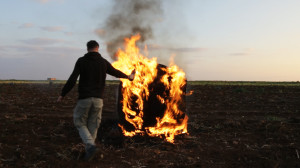
Link to the video: https://vimeo.com/manage/409262133/general
::
YIANNIS PAPPAS
Yiannis Pappas is a visual and performance artist. Throughout Pappas’ work runs a deep fascination for the relation between space and the human body in natural and urban environments. Underscored by a critical interest in space, as sites of physical and symbolic enactment, his artistic work and research explore how different places are sustained collectively and individually throughout history. An interventionist by nature, he looks for ways to find unlikely methods to engage responsiveness. His resonant and visual language includes video work, photography, performative, and installative practices, all of which bear the signs of Pappas’ anthropological and phenomenological approach toward his subjects. Yiannis Pappas was born on the island of Patmos, he lives and works in Berlin.
Degenerate Nocturne
Ernst Hugo Eduard Lorenz-Murowana (born October 27, 1872 in Murowana-Goslin, † April 22, 1954 in Berlin-Neukölln) lived and worked in Berlin as a freelance painter and also as a restorer. After completing his studies, he became a certified Aryan member of the Reich Association of Fine Artists in Germany and later in the Reich Chamber of Fine Arts in Berlin. His atmospheric depictions of the interplay between light, air and water were remarkable. The work “Fishing Boats in Southern Sun” (around 1945) was found in a Berlin’s rubbish pile by the artist and art-conservator Yiannis Pappas in 2020. Instead of the conservation of the artwork and take advantage of it, Yiannis decided to act in an anti-ideological and destructive manner, against his studies and capital’s art stocks. The performance “Degenerate Nocturne” catastrophically blackens and rejects an artwork and a story of an artist seen by dilettantes’ Nazi admirers and the way in which art is beautifully depicted. Leaving a strip of the original painting and its frame, as well as the artist’s signature as a “witness” to a constant degenerate search for ‘high Culture’ and ideal of classicism. Concept-Performance: Yiannis Pappas Music by: Dimitrios Dafnas (DE), Konstantinos Georgiou (GR), George Chondrompilas (NL)
“‘Εκφυλη Νυκτωδία”/ “‘Degenerate Nocturne” video performance 45:00
Website: Yiannis Pappas
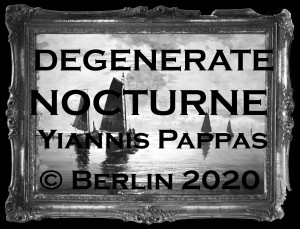
Link to the video: Yiannis Pappas – Degenerate Nocturne
::
PASHIAS
“Metaphora” PASHIAS Video performance Duration: 60’ Centre of Contemporary Art Diatopos Nicosia – Cyprus 2019
The artist believes that this video is responsive to the following notions: mythological elements of the creation of human, time, the body, antibodies and meeting.
According to his plan of action, the human figure is presented in an effort of an artificial support of a common roof, in correlation to a larger group of people. In “Metaphora” the artist’s body is placed on a pedestal while his head touches the ceiling, referring thus to the Caryatids. In a concurrent comprehension of the work, the body is inventing an alternative manner to safehold his private space, taking a distance from the “alien”, the “other” that invades this space, when the required distance cannot be maintained on the parallel plane. On the other hand, the body as scaffolding, holds the responsibility to make the space open and safe for the visitors to move.
The practice of Greek Cypriot visual artist PASHIAS is grounded in the field of performance art, installation and photography. By establishing the artist’s body as primary material for creation, PASHIAS sets up a ‘situation’ or environment, in which an audience is invited to initiate a process of action and re-action. Based on the relationship of a unit towards an ensemble, in a similar manner to how an individual is ‘received’ or ‘perceived’ within a social setting, the artist’s body is dismantled into a set of pieces, physical parts, habits or ideas, and then physically and conceptually reshaped by the ‘stance’ of audience members. Through the artist’s on-going research into social constructs (body + gender), cultural consumption (body + food), competitive spectacles (body + sports) and historical artefacts (body + exhibit), PASHIAS ultimately sets out to investigate alternative modes of presence, communication and co-existence. At these meeting points, the body in action inevitably becomes a political body, aware and responsible for its ‘time’ and ‘place’. PASHIAS has graduated from Goldsmiths University (BA) and Central Saint Martins College of Art & Design (MA) in London, whilst presenting solo exhibitions in Cyprus and Greece, and participating in group exhibitions and international festivals in the United Kingdom, France, Spain, Italy, Germany, Russia, Norway, Finland, Estonia, Sweden, Bulgaria, Turkey, Belgium, Canada and Brazil. In 2013, PASHIAS co-founded epitelesis – Performance Art Foundation as an international platform for the support of cultural activities, has been engaged in curating exhibitions and series of events on the relationship of live action to other artistic practices, and has been working as an educator/lecturer through various academic programs. http://pashias.art/
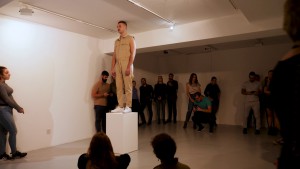
::
BILL PSARRAS
Most of his artworks and texts are on the intersections of the poetic and the technological. His art practice oscillates between walking performances for camera, site specific /mixed media installations, experimental video/digital art and poetry; focusing on the poetics of the urban experience. Bill is interested in intermedia entanglements of body, walking, objects and site; highlighting the transient, the in-between and the emotional in search of the poetic. His art thinking has been also defined by metaphors: city as an ocean of emotional, spatial and spiritual dynamics and the human as stratification of experiences and weaknesses. All form emerging conceptual and methodological platforms which weave together walking-thinking-writing. In previous site/performances for camera, he has focused on aesthetic aspects of walking; stemming from altered considerations of wider cultural concepts such as flaneur and psychogeography. The hybrid exploration of flaneur in the 21st century city also constituted the backbone of his Ph.D thesis at Goldsmiths University of London resulting into a hybrid flaneur. … More to read in the Golem Web page
Territorial Poetics (III: Vanity)
Artist: Bill Psarras
Title: Territorial Poetics (III: Vanity), Description: site-specific intervention, performance for camera & drone, stones, gold paint, Technical: HD Film 16:9, stereo sound, 13:32′
Synopsis: Territorial Poetics (III: Vanity) is part of the Territorial Poetics series of works. Vanity (~οίηση) is a site-specific performance/action for camera, where the artist pushes and piles pebbles and stones while he gradually paints them gold. Psarras carries out a durational action under the rubric ‘all our weaknesses turned into arrogant poetries’; he performs a futile action in front of the sea vastness by turning stones into gold; a silent question between poetic and political; between sincerity and arrogance; between eternal and transient. The video performance initiates from vanitas themes on the transience of earthly things focusing on a reconsideration of Sic Transit Gloria Mundi (Thus passes worldly glory)
CreditsAction camera / Drone Camera: Christos Spanos
Documentation Photography: Nansy Charitonidou
Website: billpsarras.tumblr.com/
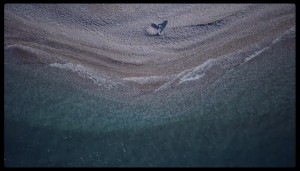
Full artwork: https://vimeo.com/424706460 Teaser: https://vimeo.com/424361702
::
MARCEL SPARMANN
I consider myself as visual based artist, experienced in theatre, dance, installation and performance art. Therefore my understanding and awareness of communication, exchanging and sharing is primarily image and action based. I’m cautious with verbalised language, but like to disintegrate the complexity of language, into poetic artistic expressions. The unfixed metaphors, the fluid mutations in the realm of deconstruction. Surrounded by visuals and their narratives, we think, speak and relate through images, identifying ourselves by codes and navigate them in cultural environments. Change is permanent. Therefore my practice follows the concept of fragility, expanding over various ideas of appearing and disappearing, traces and memories.
My artistic interest focuses on the creation of intense collective situations, compressed and formed in emotional and spiritual landscapes, in resistance. I’m interested in the exploration of a more profound understanding for compassion, kindness and bravery in the light of an unfolding vulnerability. I believe in space as an emotional and ritualistic environment and in the negotiation between the collective and common urgencies and their representations through out performance. A fertile way of manifesting the future. I’m searching for simplicity and actions which carry a pure aesthetic and oscillating temperature, maybe comparable with recent natural phenomenons.
Moon-Structures
We’ve been eating for days, every day and every day it gets more. I assume we are also feeding the table and the chairs, the floor, the walls. They all take part and swell. The chair and the table are words that grow with us. They can be easily removed from the shelf and inserted for anything. If necessary also in the crook of the arm, under the bulges and mountains, under the valleys of the stomach, tendons and muscles. They form a landscape. Our kitchen has become a landscape, depopulated like the moon.
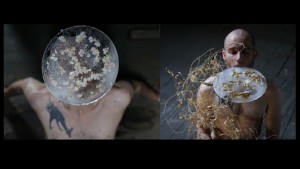
Link to the video: http://marcelsparmann.com/videowork/
::
ANGELIKI CHAIDO TSOLI
I am an interdisciplinary artist and critical thinker using text, Polaroids, walking, interventions in the public space or in private institutions, installations, memory, actions and/or performance art in my work. My work and identity as an artist has been shaped and informed by the economic and socio-political effects and systems of the financial austerity imposed in Greece. In my practice I am always interested in the process, the discovery of the unknown, the archiving of the ephemeral, the community, the absurd, the poetic, creating and transforming images within a political, identity based and ritual contextual and conceptual approach. I consider my approach as one of sculpting experiences, it is absolutely transdisciplinary and ever changing and evolving.
Self-Care Transhumanism
I will be in my private space performing some rituals of self-care beauty routines in front of the camera alongside a doll and a toy robot. Virtual bodies in virtual rooms, real reality as realistic as virtual reality.
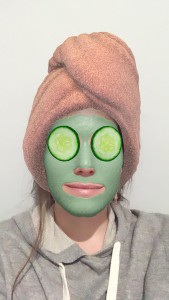
::
FILIPPOS VASSILIOU
Filippos Vasileiou lives and works in Athens. He is a graduate of the Athens School of Fine Arts, where he specialized in plaster casting, copper casting, and fresco technique. In 2009-2010 he attended the UPV in Valencia, Spain taking courses in Art of Action and Performance. He is also a Karate teacher. His art focuses on the combination of visual and martial arts. He constructs cumbersome, absurd, complex machines and costumes which force the human body and mind to be trained through them. Filippos has participated in several exhibitions in Greece and abroad as artist and activist in public spaces, trying the limits of freedom and prohibition
hotνcold -19
The artist’s activity in martial and fine arts, has led him to explore concepts like that of War. He believes that War is an unavoidable element of our existence, of nature and of our everyday lives. It is the circle of life, the flow, the connection between battle and wellbeing. For example, consider the war against the mainstream, the ordinary, the relationships between dominator and subsidiaries, victim and offender. There is a saying: “War is the father of everyone”- the Allfather. There is a constant battle between opposites. The struggle to express one’self through art is also a sort of war. The artist accepts the existence of war and how it affects him directly, as well as his surroundings. Thus, he explores the limits of contact battle and what it signifies accordingly to the intentions, the quality, the space and time during which it takes place. What is the meaning of a street fight, a “fight” on the bed, or on the tatami floor?
In the action he is presenting two male bodies struggling for domination, on a defined space of four square metres. The score is that for one hour one can pursue the opponent without a tap-out (without the choice of surrendering). After that one hour thay can continue their fight until the tap-out, for as long as it takes.
